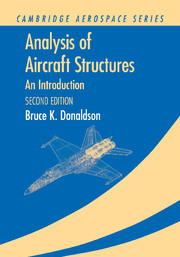Book contents
- Frontmatter
- Contents
- Introduction to the Second Edition
- Introduction to the First Edition
- List of Repeated Engineering Symbols
- Acknowledgments
- Part I The Fundamentals of Structural Analysis
- 1 Stress in Structures
- 2 Stresses and Coordinate Axis Rotations
- 3 Displacements and Strains
- 4 Strains in Rotated Coordinate Systems
- 5 The Mechanical Behavior of Engineering Materials
- 6 Linearly Elastic Materials
- Part II **Introduction to the Theory of Elasticity**
- Part III Engineering Theory for Straight, Long Beams
- Part IV Work and Energy Principles
- Part V Energy-Based Numerical Solutions
- Part VI Thin Plate Theory and Structural Stability
- Appendix A Additional Topics
- Appendix B Selected Answers to Exercises
- References
- Index
6 - Linearly Elastic Materials
from Part I - The Fundamentals of Structural Analysis
Published online by Cambridge University Press: 05 June 2012
- Frontmatter
- Contents
- Introduction to the Second Edition
- Introduction to the First Edition
- List of Repeated Engineering Symbols
- Acknowledgments
- Part I The Fundamentals of Structural Analysis
- 1 Stress in Structures
- 2 Stresses and Coordinate Axis Rotations
- 3 Displacements and Strains
- 4 Strains in Rotated Coordinate Systems
- 5 The Mechanical Behavior of Engineering Materials
- 6 Linearly Elastic Materials
- Part II **Introduction to the Theory of Elasticity**
- Part III Engineering Theory for Straight, Long Beams
- Part IV Work and Energy Principles
- Part V Energy-Based Numerical Solutions
- Part VI Thin Plate Theory and Structural Stability
- Appendix A Additional Topics
- Appendix B Selected Answers to Exercises
- References
- Index
Summary
Introduction
Chapter 5 pointed out that the mechanical and thermal response of engineering structural materials is quite complex. Nevertheless, if a uniaxial stress value lies within the bounds of the compressive and tensile elastic/proportional limits, that complex behavior becomes relatively simple. Within those two limits, or as an approximation, slight extensions of those limits to the limits of the compressive and tensile yield stresses, there is very nearly a straight-line relation between stress and strain. Moreover, that straight-line relation is very nearly the same for both loading and unloading. That is, permanent set (plastic deformation) is negligible, and the relation between stress and strain is single-valued. In other words, the stress–strain relation no longer depends upon the previous load history. Under these circumstances materials are called Hookean, or linearly elastic. In summary, on the basis of extensive experimental evidence, engineering structural materials within the yield stress limits can be and are described by a mathematical model wherein the plot of stress versus strain is exactly a straight line, and this same straight line serves the dual purpose of being a loading line and an unloading line. Thus in this chapter the focus shifts from the complicated behavior of actual engineering materials to the justifications and implications of the relatively simple linearly elastic material model.
There are three important reasons to justify restricting almost all further studies within this text to stresses whose values are limited to being within the yield stress bounds of nearly linearly elastic behavior.
- Type
- Chapter
- Information
- Analysis of Aircraft StructuresAn Introduction, pp. 146 - 164Publisher: Cambridge University PressPrint publication year: 2008



